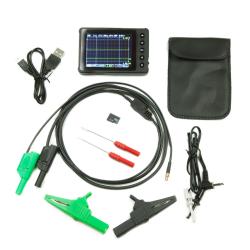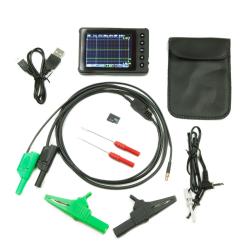Staff Answer
Jun 08, 2016 - 04:07 PM
The “AC Line Voltage” referenced in the manual refers to the high voltage that comes from a typical wall socket.
The uScope is ready for most all signals that are sandwiched within a low voltage 12 volt or 24 volt automotive system. This includes signals that are purely DC as well as AC such as a VRS.
Another confusing aspect with the term AC is the input coupling of lab scopes. The uScope only has DC input coupling built in. So, the question is, “How can I look at an AC signal such as a VRS without AC input coupling?” The answer is that for general testing of a VRS signal, you always want to use DC input coupling. If you use AC input coupling with the uScope or any scope, you could miss very important information in the signal.
For example, there are three basic circuit configurations for VRS sensors.
#1. True AC. Signal rises above the systems 0 volt and also goes below.
#2. The signal is always above the systems 0 volt because the VRS (-) is referenced directly to the system ground (the signal is riding on and rising from the system ground).
#3. The signal is above the system ground because it is riding on an always present DC voltage.
If the scope is setup to AC input coupling, the only signal you will see correctly is the true AC signal (#1). All of the others you will miss very important information.
For example, #3, if you want to see what the computer sees, you need to use DC input coupling so you can see the DC voltage and the AC sinewave that is pumping the DC voltage up and down. Keep in mind that it is the DC voltage that allows the system to check the basic integrity of the circuit when the wheel is not moving – like a C0035!
Rules of Thumb
1. For general testing always use DC input coupling which will show AC and DC. You get to see it all!
2. When you want to see only the always changing portion of a signal, use AC input coupling. For example, alternator ripples. AC input coupling will block the DC and just show the always changing portion. With the DC blocked you can go to a lower volt/division setting so you can focus in on the detail – the diode humps!
Definitions
1. AC – “Alternating Current” – electrons pushing then pulling.
2. AC Line Voltage – House voltage/current such is found in a wall socket. Deadly.
3. AC Input Coupling – When it comes to scope input coupling, AC is best to be defined as ALWAYS CHANGING…not alternating current. AC input coupling blocks the DC portion of a signal and only displays the always changing portion of a signal (referenced to the scope display 0 volt line).
Related
If your scope does not have AC input coupling, use the AES AC Pass Filter (AES# 03-90-u). Works with the uScope and most other scopes. Ideal for analyzing alternator ripple and other signals.








Add New Comment